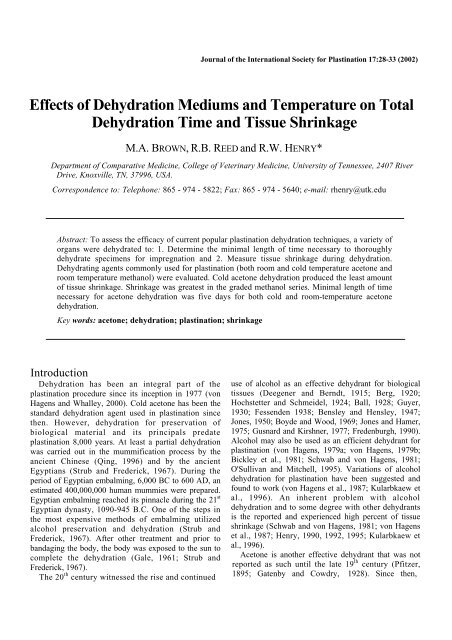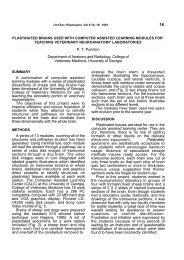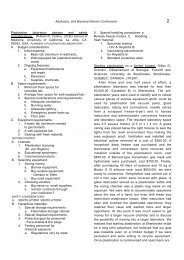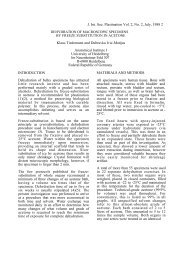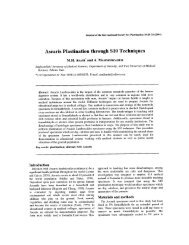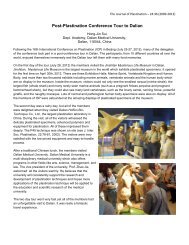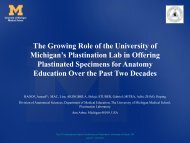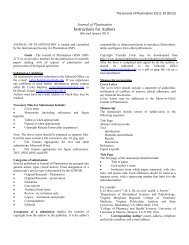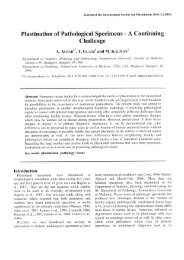Effects of Dehydration Mediums and Temperature on Total ...
Effects of Dehydration Mediums and Temperature on Total ...
Effects of Dehydration Mediums and Temperature on Total ...
You also want an ePaper? Increase the reach of your titles
YUMPU automatically turns print PDFs into web optimized ePapers that Google loves.
Journal <str<strong>on</strong>g>of</str<strong>on</strong>g> the Internati<strong>on</strong>al Society for Plastinati<strong>on</strong> 17:28-33 (2002)<str<strong>on</strong>g>Effects</str<strong>on</strong>g> <str<strong>on</strong>g>of</str<strong>on</strong>g> <str<strong>on</strong>g>Dehydrati<strong>on</strong></str<strong>on</strong>g> <str<strong>on</strong>g>Mediums</str<strong>on</strong>g> <str<strong>on</strong>g>and</str<strong>on</strong>g> <str<strong>on</strong>g>Temperature</str<strong>on</strong>g> <strong>on</strong> <strong>Total</strong><str<strong>on</strong>g>Dehydrati<strong>on</strong></str<strong>on</strong>g> Time <str<strong>on</strong>g>and</str<strong>on</strong>g> Tissue ShrinkageM.A. BROWN, R.B. REED <str<strong>on</strong>g>and</str<strong>on</strong>g> R.W. HENRY*Department <str<strong>on</strong>g>of</str<strong>on</strong>g> Comparative Medicine, College <str<strong>on</strong>g>of</str<strong>on</strong>g> Veterinary Medicine, University <str<strong>on</strong>g>of</str<strong>on</strong>g> Tennessee, 2407 RiverDrive, Knoxville, TN, 37996, USA.Corresp<strong>on</strong>dence to: Teleph<strong>on</strong>e: 865 - 974 - 5822; Fax: 865 - 974 - 5640; e-mail: rhenry@utk.eduAbstract: To assess the efficacy <str<strong>on</strong>g>of</str<strong>on</strong>g> current popular plastinati<strong>on</strong> dehydrati<strong>on</strong> techniques, a variety <str<strong>on</strong>g>of</str<strong>on</strong>g>organs were dehydrated to: 1. Determine the minimal length <str<strong>on</strong>g>of</str<strong>on</strong>g> time necessary to thoroughlydehydrate specimens for impregnati<strong>on</strong> <str<strong>on</strong>g>and</str<strong>on</strong>g> 2. Measure tissue shrinkage during dehydrati<strong>on</strong>.Dehydrating agents comm<strong>on</strong>ly used for plastinati<strong>on</strong> (both room <str<strong>on</strong>g>and</str<strong>on</strong>g> cold temperature acet<strong>on</strong>e <str<strong>on</strong>g>and</str<strong>on</strong>g>room temperature methanol) were evaluated. Cold acet<strong>on</strong>e dehydrati<strong>on</strong> produced the least amount<str<strong>on</strong>g>of</str<strong>on</strong>g> tissue shrinkage. Shrinkage was greatest in the graded methanol series. Minimal length <str<strong>on</strong>g>of</str<strong>on</strong>g> timenecessary for acet<strong>on</strong>e dehydrati<strong>on</strong> was five days for both cold <str<strong>on</strong>g>and</str<strong>on</strong>g> room-temperature acet<strong>on</strong>edehydrati<strong>on</strong>.Key words: acet<strong>on</strong>e; dehydrati<strong>on</strong>; plastinati<strong>on</strong>; shrinkageIntroducti<strong>on</strong><str<strong>on</strong>g>Dehydrati<strong>on</strong></str<strong>on</strong>g> has been an integral part <str<strong>on</strong>g>of</str<strong>on</strong>g> theplastinati<strong>on</strong> procedure since its incepti<strong>on</strong> in 1977 (v<strong>on</strong>Hagens <str<strong>on</strong>g>and</str<strong>on</strong>g> Whalley, 2000). Cold acet<strong>on</strong>e has been thest<str<strong>on</strong>g>and</str<strong>on</strong>g>ard dehydrati<strong>on</strong> agent used in plastinati<strong>on</strong> sincethen. However, dehydrati<strong>on</strong> for preservati<strong>on</strong> <str<strong>on</strong>g>of</str<strong>on</strong>g>biological material <str<strong>on</strong>g>and</str<strong>on</strong>g> its principals predateplastinati<strong>on</strong> 8,000 years. At least a partial dehydrati<strong>on</strong>was carried out in the mummificati<strong>on</strong> process by theancient Chinese (Qing, 1996) <str<strong>on</strong>g>and</str<strong>on</strong>g> by the ancientEgyptians (Strub <str<strong>on</strong>g>and</str<strong>on</strong>g> Frederick, 1967). During theperiod <str<strong>on</strong>g>of</str<strong>on</strong>g> Egyptian embalming, 6,000 BC to 600 AD, anestimated 400,000,000 human mummies were prepared.Egyptian embalming reached its pinnacle during the 21 stEgyptian dynasty, 1090-945 B.C. One <str<strong>on</strong>g>of</str<strong>on</strong>g> the steps inthe most expensive methods <str<strong>on</strong>g>of</str<strong>on</strong>g> embalming utilizedalcohol preservati<strong>on</strong> <str<strong>on</strong>g>and</str<strong>on</strong>g> dehydrati<strong>on</strong> (Strub <str<strong>on</strong>g>and</str<strong>on</strong>g>Frederick, 1967). After other treatment <str<strong>on</strong>g>and</str<strong>on</strong>g> prior tob<str<strong>on</strong>g>and</str<strong>on</strong>g>aging the body, the body was exposed to the sun tocomplete the dehydrati<strong>on</strong> (Gale, 1961; Strub <str<strong>on</strong>g>and</str<strong>on</strong>g>Frederick, 1967).The 20 th century witnessed the rise <str<strong>on</strong>g>and</str<strong>on</strong>g> c<strong>on</strong>tinueduse <str<strong>on</strong>g>of</str<strong>on</strong>g> alcohol as an effective dehydrant for biologicaltissues (Deegener <str<strong>on</strong>g>and</str<strong>on</strong>g> Berndt, 1915; Berg, 1920;Hochstetter <str<strong>on</strong>g>and</str<strong>on</strong>g> Schmeidel, 1924; Ball, 1928; Guyer,1930; Fessenden 1938; Bensley <str<strong>on</strong>g>and</str<strong>on</strong>g> Hensley, 1947;J<strong>on</strong>es, 1950; Boyde <str<strong>on</strong>g>and</str<strong>on</strong>g> Wood, 1969; J<strong>on</strong>es <str<strong>on</strong>g>and</str<strong>on</strong>g> Hamer,1975; Gusnard <str<strong>on</strong>g>and</str<strong>on</strong>g> Kirshner, 1977; Fredenburgh, 1990).Alcohol may also be used as an efficient dehydrant forplastinati<strong>on</strong> (v<strong>on</strong> Hagens, 1979a; v<strong>on</strong> Hagens, 1979b;Bickley et al., 1981; Schwab <str<strong>on</strong>g>and</str<strong>on</strong>g> v<strong>on</strong> Hagens, 1981;O'Sullivan <str<strong>on</strong>g>and</str<strong>on</strong>g> Mitchell, 1995). Variati<strong>on</strong>s <str<strong>on</strong>g>of</str<strong>on</strong>g> alcoholdehydrati<strong>on</strong> for plastinati<strong>on</strong> have been suggested <str<strong>on</strong>g>and</str<strong>on</strong>g>found to work (v<strong>on</strong> Hagens et al., 1987; Kularbkaew etal., 1996). An inherent problem with alcoholdehydrati<strong>on</strong> <str<strong>on</strong>g>and</str<strong>on</strong>g> to some degree with other dehydrantsis the reported <str<strong>on</strong>g>and</str<strong>on</strong>g> experienced high percent <str<strong>on</strong>g>of</str<strong>on</strong>g> tissueshrinkage (Schwab <str<strong>on</strong>g>and</str<strong>on</strong>g> v<strong>on</strong> Hagens, 1981; v<strong>on</strong> Hagenset al., 1987; Henry, 1990, 1992, 1995; Kularbkaew etal., 1996).Acet<strong>on</strong>e is another effective dehydrant that was notreported as such until the late 19 lh century (Pfitzer,1895; Gatenby <str<strong>on</strong>g>and</str<strong>on</strong>g> Cowdry, 1928). Since then,
<str<strong>on</strong>g>Dehydrati<strong>on</strong></str<strong>on</strong>g> 31Experiment two (shrinkage):The average shrinkage <str<strong>on</strong>g>of</str<strong>on</strong>g> cold temperature acet<strong>on</strong>edehydrated specimens was 14.5% with a range <str<strong>on</strong>g>of</str<strong>on</strong>g> 8.2%to 29%. The average shrinkage <str<strong>on</strong>g>of</str<strong>on</strong>g> room temperatureacet<strong>on</strong>e dehydrated specimens was 20.2% with a range<str<strong>on</strong>g>of</str<strong>on</strong>g> 11.1% to 34.3%. The average shrinkage <str<strong>on</strong>g>of</str<strong>on</strong>g> roomtemperature methanol dehydrated specimens was 22.6%with a range <str<strong>on</strong>g>of</str<strong>on</strong>g> 14.3% to 34.5%. The results forshrinkage for all three dehydrati<strong>on</strong> methods aredisplayed in Table 3. The average percent shrinkage forspecimens with the liver data removed was 11.2% (ca),17.9% (ra) <str<strong>on</strong>g>and</str<strong>on</strong>g> 20.8% (rm).Discussi<strong>on</strong>Minimal length <str<strong>on</strong>g>of</str<strong>on</strong>g> time to dehydrate carnivore hearts<str<strong>on</strong>g>and</str<strong>on</strong>g> kidneys was five days, which was achieved by dailychanges <str<strong>on</strong>g>of</str<strong>on</strong>g> cold <str<strong>on</strong>g>and</str<strong>on</strong>g> room temperature acet<strong>on</strong>e. Thesefindings seem to correlate with the findings <str<strong>on</strong>g>of</str<strong>on</strong>g>Tiedemann <str<strong>on</strong>g>and</str<strong>on</strong>g> Ivic-Matijas (1988) who reported coldacet<strong>on</strong>e penetrati<strong>on</strong> <str<strong>on</strong>g>of</str<strong>on</strong>g> tissue blocks to be 4-5 mm thefirst day with a maximum <str<strong>on</strong>g>of</str<strong>on</strong>g> 10mm in 4 days. Theirexperiments used tissue blocks while these carnivorespecimens were entire organs whose maximum tissuethickness was about 2.5cm. Ripani et al. (1994)suggested a markedly decreased dehydrati<strong>on</strong> time fromthe classic six weeks for parenchymatus organs (liver,spleen, kidney). They changed the cold acet<strong>on</strong>e everyother day <str<strong>on</strong>g>and</str<strong>on</strong>g> recommended a minimum <str<strong>on</strong>g>of</str<strong>on</strong>g> 3 to 4 bathsfor the best results. Their minimal length <str<strong>on</strong>g>of</str<strong>on</strong>g> dehydrati<strong>on</strong>time <str<strong>on</strong>g>of</str<strong>on</strong>g> six to ten days seems to correlate with ourtimes. As well, Ripani et al. (1996) dehydrated ratorgans, which are smaller than dog organs, in 48 hours.After dehydrati<strong>on</strong> was complete, the carnivore organswere held in 100% acet<strong>on</strong>e for 3 to 5 days to allow allspecimens to be completely dehydrated. This allowedall specimens to be impregnated together as a group.Therefore, it is possible that if residual fluid was presentin tissues after the 5 day dehydrati<strong>on</strong> period, it wouldhave been removed during this holding period. Allorgans were impregnated <str<strong>on</strong>g>and</str<strong>on</strong>g> appeared normal twelvem<strong>on</strong>ths post impregnati<strong>on</strong>. All depths <str<strong>on</strong>g>of</str<strong>on</strong>g> incised tissuewere impregnated with the polymer reacti<strong>on</strong>-mixture.The largest organs, cow heart <str<strong>on</strong>g>and</str<strong>on</strong>g> liver, took thel<strong>on</strong>gest time for dehydrati<strong>on</strong>, 12 <str<strong>on</strong>g>and</str<strong>on</strong>g> 14 daysrespectively. It was interesting that dehydrati<strong>on</strong> time forroom temperature acet<strong>on</strong>e dehydrated specimens was<strong>on</strong>e or two days quicker than cold acet<strong>on</strong>e dehydratedspecimens. This could be a slight advantage for theroom temperature dehydrati<strong>on</strong> procedure.Daily changes <str<strong>on</strong>g>of</str<strong>on</strong>g> small specimens resulted indehydrati<strong>on</strong> times <str<strong>on</strong>g>of</str<strong>on</strong>g> five to seven days, while everyother day changes had dehydrati<strong>on</strong> times <str<strong>on</strong>g>of</str<strong>on</strong>g> eight to tendays. These findings indicate that dehydrati<strong>on</strong> is mostrapid the first day in the dehydrant <str<strong>on</strong>g>and</str<strong>on</strong>g> dehydrati<strong>on</strong>rates slow slightly thereafter. This would suggest thatoptimum tissue penetrati<strong>on</strong> by acet<strong>on</strong>e is via pureacet<strong>on</strong>e with slowing <str<strong>on</strong>g>of</str<strong>on</strong>g> penetrati<strong>on</strong> up<strong>on</strong> diluti<strong>on</strong> bytissue fluid. Tiedemann <str<strong>on</strong>g>and</str<strong>on</strong>g> Ivic-Matijas (1988)proposed that after 3 three days was the most efficienttime to change the first acet<strong>on</strong>e bath. Our findings, aswell as the above, certainly seem to antiquate the olddehydrati<strong>on</strong> regime <str<strong>on</strong>g>of</str<strong>on</strong>g> three weeks, two weeks <str<strong>on</strong>g>and</str<strong>on</strong>g> then<strong>on</strong>e week (Schwab <str<strong>on</strong>g>and</str<strong>on</strong>g> v<strong>on</strong> Hagens 1981; Tiedemann<str<strong>on</strong>g>and</str<strong>on</strong>g> v<strong>on</strong> Hagens, 1982; v<strong>on</strong> Hagens 1985). Recall, thisdehydrati<strong>on</strong> regime has produced beautiful specimensfor 25 years. For ec<strong>on</strong>omy <str<strong>on</strong>g>and</str<strong>on</strong>g> quality assurance, threeor four days minimum in the dehydrating soluti<strong>on</strong>would seem to be prudent.Shrinkage was <strong>on</strong>ly 14.5% in cold temperatureacet<strong>on</strong>e while room temperature acet<strong>on</strong>e was 20.2% <str<strong>on</strong>g>and</str<strong>on</strong>g>room temperature methanol was 22.6%. These roomtemperature shrinkages were lower than the 35%reported by Holladay (1988) <str<strong>on</strong>g>and</str<strong>on</strong>g> the 44% <str<strong>on</strong>g>and</str<strong>on</strong>g> 53%reported by Schwab <str<strong>on</strong>g>and</str<strong>on</strong>g> v<strong>on</strong> Hagens (1981). Part <str<strong>on</strong>g>of</str<strong>on</strong>g> thedifference likely lies in the fact that their tissue includednervous tissue. Nerve tissue is known to have a higherpercent shrinkage at room temperature than othertissues (v<strong>on</strong> Hagens, 1985). Small animal livers had thehighest percent shrinkage <str<strong>on</strong>g>of</str<strong>on</strong>g> the four organs tested. Ifliver tissue data is removed from all dehydratedspecimen groups, the shrinkage percent is loweredacross groups by 1.7 to 3.3%. This represents a similardecrease am<strong>on</strong>g groups. This finding was somewhatsurprising since the liver is a parenchymatous organ.One might surmise that a densely cellular organ wouldshrink less than <strong>on</strong>e with a lot <str<strong>on</strong>g>of</str<strong>on</strong>g> intercellular spacebecause <str<strong>on</strong>g>of</str<strong>on</strong>g> the compactness <str<strong>on</strong>g>of</str<strong>on</strong>g> the cells resistingcollapse. These results may indicate that less silic<strong>on</strong>eenters the cells <str<strong>on</strong>g>and</str<strong>on</strong>g> more is extracellular, since livertissue has minimal intercellular tissue. It would beinteresting to look at this plastinated tissuehistologically <str<strong>on</strong>g>and</str<strong>on</strong>g> see if there was a significant decreasein cell size.Another factor that could affect results is the method<str<strong>on</strong>g>and</str<strong>on</strong>g> utensils used to measure shrinkage. Volumedisplacement seems to be an appropriate method todetermine shrinkage. However, it is difficult to obtainprecise measurements with c<strong>on</strong>venti<strong>on</strong>al lab wareespecially with larger specimens. This is because <str<strong>on</strong>g>of</str<strong>on</strong>g> thecourser calibrati<strong>on</strong> <str<strong>on</strong>g>of</str<strong>on</strong>g> lab ware as the c<strong>on</strong>tainer getslarger.The shrinkage observed using room temperaturedehydrati<strong>on</strong> is likely large enough to alter data inquantitative studies. However, for routine grossanatomy dem<strong>on</strong>strati<strong>on</strong>s, it probably would not be
32 Brown et al.perceived. Certainly shrinkage can be reduced by usingfreeze substituti<strong>on</strong>. However, the ease <str<strong>on</strong>g>of</str<strong>on</strong>g> a roomtemperature dehydrati<strong>on</strong> operati<strong>on</strong> (no lifting <str<strong>on</strong>g>of</str<strong>on</strong>g> 50L orlarge c<strong>on</strong>tainers <str<strong>on</strong>g>of</str<strong>on</strong>g> acet<strong>on</strong>e in <str<strong>on</strong>g>and</str<strong>on</strong>g> out <str<strong>on</strong>g>of</str<strong>on</strong>g> the freezer), aswell as, the need <str<strong>on</strong>g>of</str<strong>on</strong>g> fewer deep freezers may be worththe added 10% decrease in the size <str<strong>on</strong>g>of</str<strong>on</strong>g> the specimen.This decreased size may be a benefit when c<strong>on</strong>sideringthe storage <str<strong>on</strong>g>of</str<strong>on</strong>g> large specimens. Our findings c<strong>on</strong>firmpast speculati<strong>on</strong> <str<strong>on</strong>g>and</str<strong>on</strong>g> reports about the shrinkageassociated with dehydrati<strong>on</strong> using acet<strong>on</strong>e <str<strong>on</strong>g>and</str<strong>on</strong>g> alcohol.Literature citedArmed Forces. 1957: Manual <str<strong>on</strong>g>of</str<strong>on</strong>g> MacropathologicalTechniques. Washingt<strong>on</strong>, DC: Institute <str<strong>on</strong>g>of</str<strong>on</strong>g> Pathology,Medical Museum Laboratory, Walter Reed MedicalCenter, p. 302-304. Ashworth CT, Le<strong>on</strong>ard JS,Eigenbr<str<strong>on</strong>g>and</str<strong>on</strong>g>t EH, WrightmanFJ. 1966: Hepatic intracellular osmophilic droplets.Effect <str<strong>on</strong>g>of</str<strong>on</strong>g> lipid solvents during tissue preparati<strong>on</strong>. JCell Biol 31:301. Ball JM. 1928: The Sack-em-upMen. L<strong>on</strong>d<strong>on</strong>: Oliver<str<strong>on</strong>g>and</str<strong>on</strong>g> Boyd. Bensley RR, Hensley SH. 1947:H<str<strong>on</strong>g>and</str<strong>on</strong>g>book <str<strong>on</strong>g>of</str<strong>on</strong>g>histological <str<strong>on</strong>g>and</str<strong>on</strong>g> cytological technique. Chicago:University <str<strong>on</strong>g>of</str<strong>on</strong>g> Chicago Press. Berg CW. 1920:C<strong>on</strong>fessi<strong>on</strong>s <str<strong>on</strong>g>of</str<strong>on</strong>g> an undertaker. Wichita,Kansas: McCormick-Armstr<strong>on</strong>g Press. Bickley HC,v<strong>on</strong> Hagens G, Townsend FM. 1981: Animproved method for the preservati<strong>on</strong> <str<strong>on</strong>g>of</str<strong>on</strong>g> teachingspecimens. Arch Pathol Lab Med 105:674-676.Bickley HC, D<strong>on</strong>ner RS, Walker AN, Jacks<strong>on</strong> RL.1987: Preservati<strong>on</strong> <str<strong>on</strong>g>of</str<strong>on</strong>g> tissue by silic<strong>on</strong>e rubberimpregnati<strong>on</strong>. J Int Soc Plastinati<strong>on</strong> l(l):30-38. BoydeA, Wood C. 1969: Preparati<strong>on</strong> <str<strong>on</strong>g>of</str<strong>on</strong>g> animal tissuesfor surface-scanning electr<strong>on</strong> microscopy. J Microsc90:221. Bullivant J. 1965: Freeze-substituti<strong>on</strong> <str<strong>on</strong>g>and</str<strong>on</strong>g>supportingtechniques. Lab Invest 14:440-457. Deegener P,Berndt W. 1915: Process <str<strong>on</strong>g>of</str<strong>on</strong>g> preservinganimal objects. U.S. Pat. # 1,163,645. Fessenden GR.1938: Process for Preservating Plant <str<strong>on</strong>g>and</str<strong>on</strong>g>Animal Tissue U.S. Pat. No. 2,105,688. Fern<str<strong>on</strong>g>and</str<strong>on</strong>g>ez-Moran H. 1959: Electr<strong>on</strong> microscopy <str<strong>on</strong>g>of</str<strong>on</strong>g>retinal rods in relati<strong>on</strong> to localizati<strong>on</strong> <str<strong>on</strong>g>of</str<strong>on</strong>g> rhodopsin.Science 129:1284. Fern<str<strong>on</strong>g>and</str<strong>on</strong>g>ez-Moran H, DahlAO. 1952: Electr<strong>on</strong>microscopy <str<strong>on</strong>g>of</str<strong>on</strong>g> thin frozen secti<strong>on</strong>s <str<strong>on</strong>g>of</str<strong>on</strong>g> pollen grains.Science 116:465. Fredenburgh JL. 1990: Method <str<strong>on</strong>g>of</str<strong>on</strong>g>processing tissuespecimens <str<strong>on</strong>g>and</str<strong>on</strong>g> dehydrant solvent for use therein, U.S.Pat. No. 4,911,915.Gale FC. 1961: Mortuary Science. Springfield, Illinois:Charles C. Thomas, p23-32, 115-120, 204-208.Gatenby JB, EV Cowdry (editors), 1928: Bolles Lee'sMicrotomist's Vade-Mecum: A H<str<strong>on</strong>g>and</str<strong>on</strong>g>book <str<strong>on</strong>g>of</str<strong>on</strong>g> theMethods <str<strong>on</strong>g>of</str<strong>on</strong>g> Microscopic Anatomy. Philadelphia, PA:P. Blakist<strong>on</strong>'sS<strong>on</strong>&Co.Glauert AM (Editor). 1974: Practical methods inelectr<strong>on</strong> microscopy, Vol. 3. Oxford: North-Holl<str<strong>on</strong>g>and</str<strong>on</strong>g>Pub. Co., p.l 11-117.Gusnard D, Kirshner RH. 1977: Cell <str<strong>on</strong>g>and</str<strong>on</strong>g> organelleshrinkage during preparati<strong>on</strong> for scanning electr<strong>on</strong>microscopy: effects <str<strong>on</strong>g>of</str<strong>on</strong>g> fixati<strong>on</strong>, dehydrati<strong>on</strong> <str<strong>on</strong>g>and</str<strong>on</strong>g>critical point drying. J Microscopy 110(l):51-57.Guyer MF. 1930: Animal Micrology: Practical ExerciseIn Zoological Micro-Technique. Chicago: University<str<strong>on</strong>g>of</str<strong>on</strong>g> Chicago Press, p. 17-18.Hangay G, Dingley M. 1985: Biological MuseumMethods, Vol. 1, Vertebrates. New York <str<strong>on</strong>g>and</str<strong>on</strong>g> Sydney:Academic Press (Harcourt Brace Jovanovich,Publishers), p. 49, 278, 302-303, 306.Henry RW. 1990: <str<strong>on</strong>g>Dehydrati<strong>on</strong></str<strong>on</strong>g> <str<strong>on</strong>g>of</str<strong>on</strong>g> specimens forplastinati<strong>on</strong>. J Int Soc Plastinati<strong>on</strong> 4(1):8.Henry RW. 1992: <str<strong>on</strong>g>Dehydrati<strong>on</strong></str<strong>on</strong>g> <str<strong>on</strong>g>of</str<strong>on</strong>g> specimens, J Int SocPlastinati<strong>on</strong> 6(1):4. Henry RW. 1995: Principles<str<strong>on</strong>g>of</str<strong>on</strong>g> plastinati<strong>on</strong> -<str<strong>on</strong>g>Dehydrati<strong>on</strong></str<strong>on</strong>g> <str<strong>on</strong>g>of</str<strong>on</strong>g> specimens. J Int Soc Plastinati<strong>on</strong>9(1):27. Henry RW. 1998: Principles <str<strong>on</strong>g>of</str<strong>on</strong>g> Plastinati<strong>on</strong>.J Int SocPlastinati<strong>on</strong> 13(2):27. Henry RW, Brown A, Reed RB.1998: Current topics<strong>on</strong> <str<strong>on</strong>g>Dehydrati<strong>on</strong></str<strong>on</strong>g>. J Int Soc Plastinati<strong>on</strong> 13(2):27-28.Hochstetter F, Schmeidel G, 1924: Method or process<str<strong>on</strong>g>of</str<strong>on</strong>g> permanently preserving animals <str<strong>on</strong>g>and</str<strong>on</strong>g> plants. US Pat.No. 1,602,489.Holladay SD. 1988: Experiments in dehydrati<strong>on</strong>techniques. J Int Soc Plastinati<strong>on</strong> 2(2): 17-20.J<strong>on</strong>es EC, Hamer JD. 1975: Scanning electr<strong>on</strong>microscopy <str<strong>on</strong>g>of</str<strong>on</strong>g> the luminal epithelium <str<strong>on</strong>g>of</str<strong>on</strong>g> the mouseuterus. J Reprod Fert 42:95-104.J<strong>on</strong>es RM, editor. 1950: McCLung's h<str<strong>on</strong>g>and</str<strong>on</strong>g>book <str<strong>on</strong>g>of</str<strong>on</strong>g>Microscopial Technique for workers in animal <str<strong>on</strong>g>and</str<strong>on</strong>g>plant tissues. New York: Hafner Publishing Co.Knudsen, JW, 1966: Biological Techniques. New York:Harper <str<strong>on</strong>g>and</str<strong>on</strong>g> Row Publishers.Kularbkaew C, Cook P, Yutanawibo<strong>on</strong>chai W, v<strong>on</strong>Hagens G. 1996: Plastinated pathology specimens atroom temperature in Thail<str<strong>on</strong>g>and</str<strong>on</strong>g>. J Int Soc Plastinati<strong>on</strong>11(1): 17-20.Lischka M, Prohoda F, 1987: Establishing <str<strong>on</strong>g>and</str<strong>on</strong>g>operating a Plastinati<strong>on</strong> laboratory at the Institute <str<strong>on</strong>g>of</str<strong>on</strong>g>
Anatomy, University <str<strong>on</strong>g>of</str<strong>on</strong>g> Vienna. J Int Soc Plastinati<strong>on</strong>Lutz E. 1969: H<str<strong>on</strong>g>and</str<strong>on</strong>g>book <str<strong>on</strong>g>of</str<strong>on</strong>g> Plastic Embedding.Healdsburg, CA: Naturegraph Publishers. Mah<strong>on</strong> G.1938: Stain for myelin sheaths in tissuesembedded in paraffin. Arch Neurol Psychiatr 38:103-107. Nicaise M, Simoens P, Lauwers H. 1990:Plastinati<strong>on</strong><str<strong>on</strong>g>of</str<strong>on</strong>g> organs: a unique technique for preparati<strong>on</strong> <str<strong>on</strong>g>of</str<strong>on</strong>g>illustrative dem<strong>on</strong>strati<strong>on</strong> specimens. VlaamsDiergeneeskd Tijdschr (Flemish Veterinary Journal)59:141-146. 0'Sullivan E, Mitchell BS. 1995:Plastinati<strong>on</strong> for grossanatomy teaching using low cost equipment. Surg RadAnat 17:277-281. Pfitzer E. 1895: Process <str<strong>on</strong>g>of</str<strong>on</strong>g>preserving flowers, leaves,<str<strong>on</strong>g>and</str<strong>on</strong>g> c [sic]. US Pat No 547,227. Qing, XY. 1996:The ancient corpses in China.Shanghai, China: Shanghai Scientific <str<strong>on</strong>g>and</str<strong>on</strong>g>Technological Educati<strong>on</strong> Publishing House. Ripani M,Bassi A, Perracchio L, Panebianco V, PerezM, Boccia ML, Marinozzi G. 1994: M<strong>on</strong>itoring <str<strong>on</strong>g>and</str<strong>on</strong>g>enhancement <str<strong>on</strong>g>of</str<strong>on</strong>g> fixati<strong>on</strong>, dehydrati<strong>on</strong>, forcedimpregnati<strong>on</strong> <str<strong>on</strong>g>and</str<strong>on</strong>g> cure in the st<str<strong>on</strong>g>and</str<strong>on</strong>g>ard S-10 technique.J Int Soc Plastinati<strong>on</strong> 8(l):3-5. Ripani M, BocciaML, Cerv<strong>on</strong>e, P, De VargasMacciucca M. 1996: Light microscopy <str<strong>on</strong>g>of</str<strong>on</strong>g> plastinatedtissue. Can plastinated organs be c<strong>on</strong>sidered viable forstructural observati<strong>on</strong>? J Int Soc Plastinati<strong>on</strong> 11(1):28-30. Schwab K, v<strong>on</strong> Hagens G. 1981: Freezesubstituti<strong>on</strong> <str<strong>on</strong>g>of</str<strong>on</strong>g>macroscopic specimens for plastinati<strong>on</strong>. Acta Anat111:139-140.Strub CG, Frederick LG. 1967: The principles <str<strong>on</strong>g>and</str<strong>on</strong>g>practice <str<strong>on</strong>g>of</str<strong>on</strong>g> embalming. Dallas: L. G. Frederick.Thijssen HAC. 1972: Process for dehydrating, defatting,<str<strong>on</strong>g>and</str<strong>on</strong>g> deodorizing animal tissue. US Pat No 3,649,294.Tiedemann K, v<strong>on</strong> Hagens G. 1982: The technique <str<strong>on</strong>g>of</str<strong>on</strong>g>heart plastinati<strong>on</strong>. Anat Rec 204:295-299.<str<strong>on</strong>g>Dehydrati<strong>on</strong></str<strong>on</strong>g> 33Tiedemann, K, D Ivic-Matijas, 1988: <str<strong>on</strong>g>Dehydrati<strong>on</strong></str<strong>on</strong>g> <str<strong>on</strong>g>of</str<strong>on</strong>g>macroscopic specimens by freeze substituti<strong>on</strong> inacet<strong>on</strong>e. J Int Soc Plastinati<strong>on</strong> 2(2):2-12.v<strong>on</strong> Hagens G. 1979a: Impregnati<strong>on</strong> <str<strong>on</strong>g>of</str<strong>on</strong>g> s<str<strong>on</strong>g>of</str<strong>on</strong>g>t biologicalspecimens with thermosetting resins <str<strong>on</strong>g>and</str<strong>on</strong>g> elastomers.Anat Rec 194(2): 247-25 5.v<strong>on</strong> Hagens G. 1979b: Emulsifying resins forplastinati<strong>on</strong>. Der Praparator 25(2):43-50.v<strong>on</strong> Hagens G. 1980: Animal <str<strong>on</strong>g>and</str<strong>on</strong>g> vegetal tissuespermanently preserved by synthetic resinimpregnati<strong>on</strong>. US Pat No 4,205,059.v<strong>on</strong> Hagens G. 1981a: Animal <str<strong>on</strong>g>and</str<strong>on</strong>g> vegetal tissuespermanently preserved by synthetic resinimpregnati<strong>on</strong>. US Pat No 4,244,992.v<strong>on</strong> Hagens G. 1981b: Animal <str<strong>on</strong>g>and</str<strong>on</strong>g> vegetal tissuespermanently preserved by synthetic resinimpregnati<strong>on</strong>. US Pat No 4,278,701.v<strong>on</strong> Hagens G. 1982: Method for preserving largesecti<strong>on</strong>s <str<strong>on</strong>g>of</str<strong>on</strong>g> biological tissue with polymers. US Pat No4,320,157.v<strong>on</strong> Hagens G. 1985: Heidelberg Plastinati<strong>on</strong> Folder:Collecti<strong>on</strong> <str<strong>on</strong>g>of</str<strong>on</strong>g> all technical leaflets for plastinati<strong>on</strong>. D-6900 Heidelberg, Germany: Anatomisches Institut I,Universitat Heidelberg.v<strong>on</strong> Hagens G, Tiedemann K, Kriz W. 1987: Thecurrent potential <str<strong>on</strong>g>of</str<strong>on</strong>g> plastinati<strong>on</strong>. Anat Embryol175:411-421.v<strong>on</strong> Hagens G, Whalley A. 2000: Anatomy art:Fascinati<strong>on</strong> beneath the surface. D-69126 Heidelberg:Institute for Plastinati<strong>on</strong>.Weidemann JA. 1938: Method <str<strong>on</strong>g>of</str<strong>on</strong>g> fixing <str<strong>on</strong>g>and</str<strong>on</strong>g> preservinggross anatomical specimens <str<strong>on</strong>g>and</str<strong>on</strong>g> the like. US Pat No2,106,261Zheng TZ, Weatherhead B, Gosling J. 1996:Plastinati<strong>on</strong> at room temperature. J Int SocPlastinati<strong>on</strong> 11(1):33.Zheng TZ, Jingren L, Kerming Z. 1998: Plastinati<strong>on</strong> atroom temperature. J Int Soc Plastinati<strong>on</strong> 13(2):21-25.


